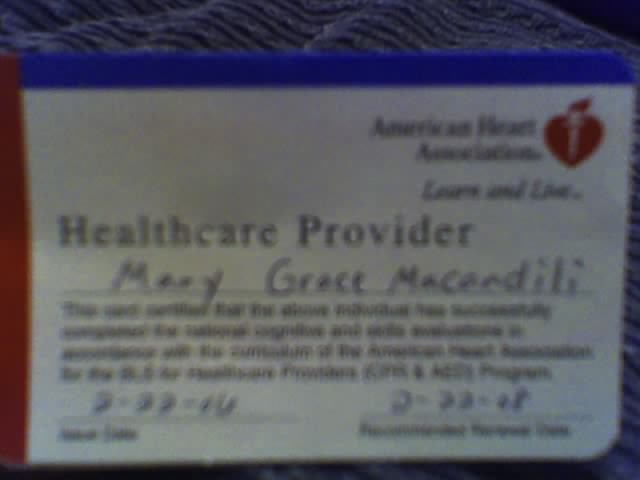2.21.2006
AHA: Basic Life Support [Renewal Course]
 Basic Life Support for Healthcare Providers
Basic Life Support for Healthcare Providers
My BLS certification expired last January and technically, I was only allowed to take renewal course 30 days after it expired or else i would have had to take the full 8 hour BLS course. Luckily for me i got in the last renewal class for this month.
It was a 3 hour session with 14 other "students". The first thing we did was to watch a video on the basics. We reviewed the ABCD's of BLS for adults, pediatrics and infants. Heimlich maneuver was also covered for choking victims. The chain of survival for both adults and pediatrics were briefly discussed. The inevitable skills check off came next to the agenda were we were paired 2-3 people in one group. And last but not the least, the BLS test.
I'll talk about each stage whether you like it or not since i do the blog work. For anyone who might stumble in to this blog and finds out that anything is out of line, please let me know so i don't become a mockery of myself.
1. ABCD - this is the mnemonics for airway, breathing, circulation & defibrillation which is crucial in adult and pediatric resuscitation efforts. This is true to healthcare providers but for layperson / non-healthcare providers, checking the circulation or finding the pulse is going to be eliminated by AHA guidelines since it takes too much time for them to find what is necessary thus reducing the time to do the next crucial step of chest compressions. [This statement is according out instructor since AHA will be releasing new guidelines for BLS this coming September 2006]. The following steps is what i have learned for adult CPR. Pediatric CPR mandates the care provider to do CPR first for one minute before calling the EMS. The scenario for all of the following steps is mostly when you are alone on a general public setting.
REMINDER: This entire thing is for the sole purpose of retaining my knowledge and is not intended to be utilized for own personal education or reference. Please refer to professional sites that i will include at the end of this text and also on my links. I will not be liable for any injury that may occur in refering to this blog.
- Check for responsiveness. Do whatever you need to do to make sure the person is not in any way conscious.
- If unresponsive, call 911. When you are on a public setting, there's a lot of bystanders who have access to their cellphone. Make use of them at this time and elt them know that an AED and ambulance is needed right away.
- Check the airway. Look for signs of any foreign objects in the mouth and do blind sweep in the mouth, being careful not to push anything down the throat. Open the airway by doing a head tilt manuever. (Only for professionals) Use jaw thrust manuever if trauma is suspected.
- Check for signs of breathing. Do you feel air coming out from mouth or nose? Do you see the chest rising? If answered yes to both question, the patient is breathing. If not breathing, give 2 rescue breaths while opening the airway.
- Check for circulation. Find the carotid pulse. If absent, start doing 15 chest compressions. Be careful not to do compressions on the xyphoid process to avoid injury to patient. One can find the spot where to do compressions by looking at the nipple alignment and using the center of it to do chest compressions or by followin the ridge of the ribcage towards the xyphoid process and going 3-4 fingers up from there.
- Use the AED or Automatic External Defibrillator. Alternate 15 compressions to 2 breaths. Do the cycle 4 times or for one whole minute then check again for circulation. If AED is present; start the AED, attach electrode pads to appropriate area or as directed, follow instructions as directed by the voice direction system. If shock is indicated, make sure everybody is "clear" or not touching the patient before delivering the shock. The AED will continue to analyze patient 3 times or until it deterines an unshockable rhythm.
- Check your ABC's again and perform CPR if circulation is not present until EMS or the ambulance arrives.
Notes:Before using AED, make sure you check 4 things: [1] Age of patient: AED's mostly have pediatric pads but can only be used for children >1 year old [2] Patient is dry and not on a wet surface [3] Keep pacemakers and AICD's as far away from the electrode pads since it may impede the flow of energy [4] Take off medication patches if present and dry thoroughly before electrode pads are applied
2.
Choking & Heimlich Maneuver - The same steps and guidelines are the same for choking victims both adults and children >1 yr old. The universal sign for choking is hand on their neck. Heimlich manuever is used for both age grop while infants <1 yr old needs to have 5 back blows and 5 chest thrusts while stabilizing the neck and the head. [I strongly recommend that anyone who reads this must get their certification or their knowledge from a licensed organization before attempting to help an infant choke victim.]
- Ask the person if he/she is choking, then ask if he/she can cough or talk If the patient responds yes to choking and no to talking r coughing (of course they will do shake their head if theyre not talking, duh!), tell them that you are going to help them, wrap your arms around the person, then make a fist on you right hand, put the flat thumb just above the navel and well below the xyphiod process, hold the right hand with the left hand and do abdominal thrusts until the foreign object is disodged or the pateint becomes unconcious.
- If patient becomes unconscious, Lay the patient slowly down to the floor on a supine position. For adults, do a blind sweep, do a head tilt, attempt 2 rescue breaths, straddle the patient on the thighs and do 5 abdominal thrusts. Alternating 2 rescue breaths and 5 abdominal thrusts until foreign object is dislodged.
Note: If this persists and patient remained unconscious after several attempts, check circulation and begin CPR if needed until EMS arrives.
3.
Chain of Survival - These are critical actions that are performed by rescuers that links the victim of cardiovascular emergency to survival.
- ADULTS [1] Early access to EMS or Emergency Medical Services or 911 [2] early CPR [3] eary defibrillation [4] early advanced life support
- PEDIATRICS [1] prevention of injuries or emergencies requiring resuscitation [2] early CPR [3] early defibrillation {4] early advanced life support
Note: Excerpt from Heartsaver CPR for Schools - PDF manual
[americanheart.org - page 4].
I am not going to elaborate the skills check off and the test. It is easy if you truly listen to their subtle (or not so subtle) hints. Mind you, we were laughing at some rumor, at the expense of one cardiologist that failed the first test. He had to take the second test to pass.
---------------------------------------------------------------------------------
American Heart AssociationWorldPoint-ECC, IncChanning Bete CompanyLaerdal Medical Corporation
Posted by nixinne ::
23:55 ::
0 comments

Post a Comment
---------------oOo---------------

